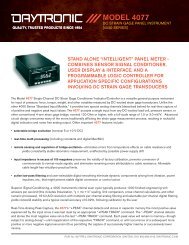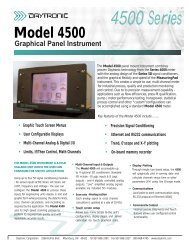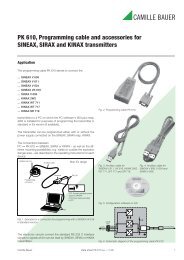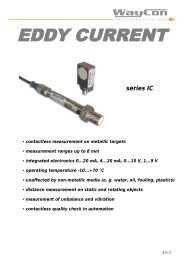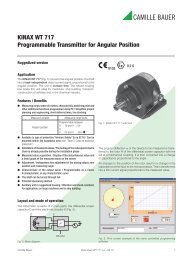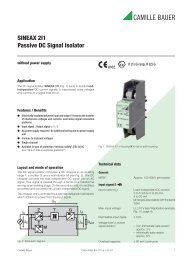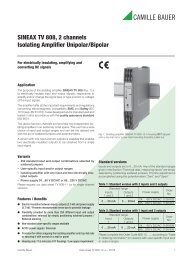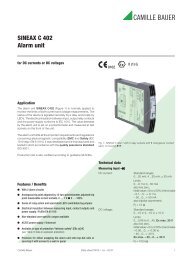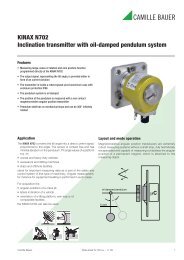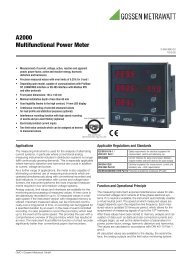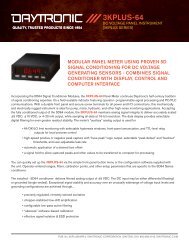SINEAX DME 440 with RS 485 interface Programmable Multi ...
SINEAX DME 440 with RS 485 interface Programmable Multi ...
SINEAX DME 440 with RS 485 interface Programmable Multi ...
Create successful ePaper yourself
Turn your PDF publications into a flip-book with our unique Google optimized e-Paper software.
<strong>SINEAX</strong> <strong>DME</strong> <strong>440</strong> <strong>with</strong> <strong>RS</strong> <strong>485</strong> <strong>interface</strong><strong>Programmable</strong> <strong>Multi</strong>-Transducerfor the measurement of electrical variables in heavycurrentpower systemApplication<strong>SINEAX</strong> <strong>DME</strong> <strong>440</strong> (Fig. 1) is a programmable transducer <strong>with</strong> a<strong>RS</strong> <strong>485</strong> bus <strong>interface</strong> (MODBUS ® ). It supervises several variablesof an electrical power system simultaneously and generates 4proportional analogue output signals.The <strong>RS</strong> <strong>485</strong> <strong>interface</strong> enables the user to determine the numberof variables to be supervised (up to the maximum available). Thelevels of all internal energy meters that have been confi gured (max.4) can also viewed. Provision is made for programming the <strong>SINEAX</strong><strong>DME</strong> <strong>440</strong> via the bus. A standard EIA <strong>485</strong> <strong>interface</strong> can be used,but there is no dummy load resistor for the bus.The transducers are also equipped <strong>with</strong> an <strong>RS</strong> 232 serial <strong>interface</strong>to which a PC <strong>with</strong> the corresponding software can be connectedfor programming or accessing and executing useful ancillaryfunctions. This <strong>interface</strong> is needed for bus operation to confi gurethe device address, the Baud rate and possibly increasing thetelegram waiting time (if the master is too slow) defi ned in theMODBUS ® protocol.The usual methods of connection, the types of measured variables,their ratings, the transfer characteristic for each output and thetype of internal energy meter are the main parameters that canbe programmed.The ancillary functions include a power system check, provisionfor displaying the measured variably on a PC monitor, the simulationof the outputs for test purposes and a facility for printingnameplates.The transducer fulfi ls all the essential requirements and regulationsconcerning electromagnetic compatibility (EMC) and safety(IEC 1010 resp. EN 61 010). It was developed and is manufacturedand tested in strict accordance <strong>with</strong> the quality assurancestandard ISO 9001.Features / Benefits● Simultaneous measurement of several variables of a heavy-currentpower system / Full supervision of an asymmetrically loaded fourwirepower system, rated current 1 to 6 A, rated voltage 57 to 400 V(phase-to-neutral) or 100 to 693 V (phase-to-phase)● For all heavy-current power system variables● 4 analogue outputs● Input voltage up to 693 V (phase-to-phase)● Universal analogue outputs (programmable)● High accuracy: U/I 0.2% and P 0.25% (under reference conditions)● 4 integrated energy meters, storage every each 203 s, storage for:20 yearsFig. 1. <strong>SINEAX</strong> <strong>DME</strong> <strong>440</strong> in housing T24,clipped onto a top-hat rail.● Windows software <strong>with</strong> password protection for programming, dataanalysis, power system status simulation, acquisition of meter dataand making settings● DC-, AC-power pack <strong>with</strong> wide power supply tolerance / universal● Provision for either snapping the transducer onto top-hat rails orsecuring it <strong>with</strong> screws to a wall or panelMeasured variables Output TypesCurrent, voltage (rms),active/reactive/apparentpowercosϕ, sinϕ, power factorRMS value of the current<strong>with</strong> wire setting range(bimetal measuringfunction)Slave pointer function forthe measurement of theRMS value IBFrequencyAverage value of thecurrents <strong>with</strong> sign of theactive power (powersystem only)4 analog outputs andbus <strong>RS</strong> <strong>485</strong> (MODBUS)2 analog outputs and4 digital outputsor4 analog outputs and2 digital outputs, see datasheet <strong>DME</strong> 424/442-1 LeData bus LON, see datasheet <strong>DME</strong> 400-1 LeWithout analog outputs,<strong>with</strong> bus <strong>RS</strong> <strong>485</strong> (MODBUS)see data sheet<strong>DME</strong> 401-1 LePROFIBUS DP see datasheet <strong>DME</strong> 406-1 Le<strong>DME</strong> 424<strong>DME</strong> 442<strong>DME</strong> 400<strong>DME</strong> 401<strong>DME</strong> 406Camille Bauer Data Sheet <strong>DME</strong> <strong>440</strong>-1 Le – 08.08 1
<strong>SINEAX</strong> <strong>DME</strong> <strong>440</strong> <strong>with</strong> <strong>RS</strong> <strong>485</strong> <strong>interface</strong><strong>Programmable</strong> <strong>Multi</strong>-Transducer1 2I1I2I3L1L2L3N111 = Input transformer2 = <strong>Multi</strong>plexer3 = Latching stage4 = A/D converter5 = Microprocessor6 = Electrical insulationFig. 2. Block diagram.SymbolsSymbolsXX0X1X2YY0Y1Y2UUrU 12U 23U 31U1NU2NU3N34 5A/D69<strong>RS</strong>-23267 8D/AD/AD/AD/A10ABCD<strong>RS</strong>-<strong>485</strong>7 = D/A converter8 = Output amplifier / Latching stage9 = Programming <strong>interface</strong> <strong>RS</strong>-23210 = Bus <strong>RS</strong> <strong>485</strong> (MODBUS)11 = Power supplyMeaningMeasured variableLower limit of the measured variableBreak point of the measured variableUpper limit of the measured variableOutput variableLower limit of the output variableBreak point of the output variableUpper limit of the output variableInput voltageRated value of the input voltagePhase-to-phase voltage L1 – L2Phase-to-phase voltage L2 – L3Phase-to-phase voltage L3 – L1Phase-to-neutral voltage L1 – NPhase-to-neutral voltage L2 – NPhase-to-neutral voltage L3 – NUMAverage value of the voltages(U1N + U2N + U3N) / 3IInput currentI1AC current L1I2AC current L2I3AC current L3IrRated value of the input currentIM Average value of the currents (I1 + I2 + I3) / 3SymbolsIMSIBIBTBSBSTϕFFnPP1P2P3QQ1Q2Q3SS1S2S3MeaningAverage value of the currents and sign of theactive power (P)RMS value of the current <strong>with</strong> wire settingrange (bimetal measuring function)Response time for IBSlave pointer function for the measurement ofthe RMS value IBResponse time for BSPhase-shift between current and voltageFrequency of the input variableRated frequencyActive power of the system P = P1 + P2 + P3Active power phase 1(phase-to-neutral L1 – N)Active power phase 2(phase-to-neutral L2 – N)Active power phase 3(phase-to-neutral L3 – N)Reactive power of the systemQ = Q1 + Q2 + Q3Reactive power phase 1(phase-to-neutral L1 – N)Reactive power phase 2(phase-to-neutral L2 – N)Reactive power phase 3(phase-to-neutral L3 – N)Apparent power of the systemS = √ I 12+ I 22+ I 32· √ U 12+ U 22+ U 32Apparent power phase 1(phase-to-neutral L1 – N)Apparent power phase 2(phase-to-neutral L2 – N)Apparent power phase 3(phase-to-neutral L3 – N)SrRated value of the apparent power of thesystemPF Active power factor cosϕ = P/SPF1 Active power factor phase 1 P1/S1PF2 Active power factor phase 2 P2/S2PF3 Active power factor phase 3 P3/S3QF Reactive power factor sin ϕ = Q/SQF1 Reactive power factor phase 1 Q1/S1QF2 Reactive power factor phase 2 Q2/S2QF3 Reactive power factor phase 3 Q3/S3LFLF1LF2LF3Power factor of the systemLF = sgnQ · (1 – ⏐PF⏐)Power factor phase 1sgnQ1 · (1 – ⏐PF1⏐)Power factor phase 2sgnQ2 · (1 – ⏐PF2⏐)Power factor phase 3sgnQ3 · (1 – ⏐PF3⏐)2 Data Sheet <strong>DME</strong> <strong>440</strong>-1 Le – 08.08 Camille Bauer
<strong>SINEAX</strong> <strong>DME</strong> <strong>440</strong> <strong>with</strong> <strong>RS</strong> <strong>485</strong> <strong>interface</strong><strong>Programmable</strong> <strong>Multi</strong>-TransducerSymbolscRRnHHnCTVTMeaningFactor for the intrinsic errorOutput loadRated burdenPower supplyRated value of the power supplyc.t. ratiov.t. ratioApplicable standards and regulationsEN 60 688IEC 1010 orEN 61 010EN 60529IEC 255-4 Part E5IEC 1000-4-2, 3, 4, 6VDI/VDE 3540,page 2DIN 40 110DIN 43 807IEC 68 /2-6EN 55011IEC 1036DIN 43864UL 94Electrical measuring transducers for convertingAC electrical variables into analogand digital signalsSafety regulations for electrical measuring,control and laboratory equipmentProtection types by case (code IP)High-frequency disturbance test (staticrelays only)Electromagnetic compatibility for industrial-processmeasurement and controlequipmentReliability of measuring and control equipment(classifi cation of climates)AC quantitiesTerminal markingsBasic environmental testing procedures,vibration, sinusoidalElectromagnetic compatibility of dataprocessing and telecommunicationequipmentLimits and measuring principles for radiointerference and information equipmentAlternating current static watt-hour metersfor active energy (classes 1 and 2)Current <strong>interface</strong> for the transmissionof impulses between impulse encodercounter and tarif meterTests for fl ammability of plastic materialsfor parts in devices and appliancesConsumption:Voltage circuit: ≤ U 2 / 400 kΩCondition:external power supplyCurrent circuit: 0.3 VA · I/5 AContinuous thermal ratings of inputsCurrent circuit 10 A 400 Vsingle-phase AC system693 Vthree-phase systemVoltage circuit 480 V single-phase AC system831 V three-phase systemShort-time thermal rating of inputsInputvariableNumberof inputsDurationofoverloadIntervalbetween twooverloadsCurrent circuit 400 V single-phase AC system693 V three-phase system100 A 5 3 s 5 min.250 A 1 1 s 1 hourVoltage circuit 1 A, 2 A, 5 ASingle-phaseAC system600 VH intern: 1.5 Ur10 10 s 10 sThree-phasesystem1040 VH intern: 1.5 UrMODBUS ® (Bus <strong>interface</strong> <strong>RS</strong>-<strong>485</strong>)10 10 s 10 sTerminals: Screw terminals, terminals 23, 24, 25and 26Connecting cable: Screened twisted pairMax. distance: Approx. 1200 m (approx. 4000 ft.)Baudrate:1200 … 9600 Bd (programmable)Number of busstations:32 (including master)Dummy load: Not requiredTechnical dataInputs+–GNDInput variables: see Table 2 and 3Measuring ranges: see Table 2 and 3Waveform:SinusoidalRated frequency:50…60 Hz; 16 2/3 Hz2324 25 26MODBUS ® is a registered trademark of the Schneider Automation Inc.Camille Bauer Data Sheet <strong>DME</strong> <strong>440</strong>-1 Le – 08.08 3
<strong>SINEAX</strong> <strong>DME</strong> <strong>440</strong> <strong>with</strong> <strong>RS</strong> <strong>485</strong> <strong>interface</strong><strong>Programmable</strong> <strong>Multi</strong>-TransducerAnalog outputsFor the outputs A, B, C and D:Output variable YFull scale Y2ImpressedDC currentsee “Orderinginformation”ImpressedDC voltagesee “Orderinginformation”Limits of outputsignal for inputoverloadand/or R = 0 1.25 · Y2 40 mAR → ∞ 30 V 1.25 Y2Rated useful rangeof output loadAC component ofoutput signal(peak-to-peak)0 ≤ 7.5 V ≤ 15 VY2 Y2≤ 0.005 Y2Y2 ≤Y2 ≤ ∞2 mA 1 mA≤ 0.005 Y2The outputs A, B, C and D may be either short or open-circuited.They are electrically insulated from each other and from all othercircuits (fl oating).All the full-scale output values can be reduced subsequently usingthe programming software, but a supplementary error results.The hardware full-scale settings for the analog outputs may alsobe changed subsequently. Conversion of a current to a voltageoutput or vice versa is also possible. This necessitates changingresistors on the output board. The full-scale values of the currentand voltage outputs are set by varying the effective value of twoparallel resistors (better resolution). The values of the resistors areselected to achieve the minimum absolute error. Calibration <strong>with</strong>the programming software is always necessary following conversionof the outputs. Refer to the Operating Instructions. Caution:The warranty is void if the device is tampered <strong>with</strong>!Reference conditionsAmbient temperature: 15 … 30 °CPre-conditioning: 30 min. acc. to EN 60 688Section 4.3, Table 2Input variable:Rated useful rangePower supply: H = Hn ± 1%Active/reactive factor: cosϕ = 1 resp. sinϕ = 1Frequency:50 … 60 Hz, 16 2/3 HzWaveform: Sinusoidal, form factor 1.1107Output load:DC current output:7.5 VR n= ± 1%Y2DC voltage output:System responseAccuracy class:MeasuredvariableSystem:Active, reactiveand apparentpowerPhase:Active, reactiveand apparentpowerPower factor,active powerfactor andreactive powerfactor(the reference value is the full-scalevalue Y2)Condition0.5 ≤ X2/Sr ≤ 1.50.3 ≤ X2/Sr < 0.50.167 ≤ X2/Sr ≤ 0.50.1 ≤ X2/Sr < 0.1670.5Sr ≤ S ≤ 1.5 Sr,(X2 - X0) = 20.5Sr ≤ S ≤ 1.5 Sr,1 ≤ (X2 - X0) < 20.5Sr ≤ S ≤ 1.5 Sr,0.5 ≤ (X2 - X0) < 10.1Sr ≤ S < 0.5Sr,(X2 - X0) = 20.1Sr ≤ S < 0.5Sr,1 ≤ (X2 - X0) < 20.1Sr ≤ S < 0.5Sr,0.5 ≤ (X2 - X0) < 1Accuracy class*0.25 c0.5 c0.25 c0.5 c0.25 c0.5 c1.0 c0.5 c1.0 c2.0 cAC voltage 0.1 Ur ≤ U ≤ 1.2 Ur 0.2 cAC current/currentaverages0.1 Ir ≤ I ≤ 1.5 Ir 0.2 cSystemfrequency0.1 Ur ≤ U ≤ 1.2 Urresp.0.1 Ir ≤ I ≤ 1.5 Ir0.15 + 0.03 c(f N= 50...60 Hz)0.15 + 0.1 c(f N= 16 2/3 Hz)acc. to IEC 1036Energy meter1.00.1 Ir ≤ I ≤ 1.5 Ir* Basic accuracy 0.5 c for applications <strong>with</strong> phase-shiftDuration of themeasurement cycle:Response time:Factor c (the highest value applies:Linear characteristic:Bent characteristic:X0 ≤ X ≤ X1Approx. 0.5 to s 1.2 s at 50 Hz,depending on measured variable andprogramming1 … 2 times the measurement cyclec =1 - Y0 Y2or c = 11 - X0X2c = Y1 – Y0 · X2 or c = 1X1 – X0 Y2Y2R n=1 mAMiscellaneous: EN 60 688± 1%X1 < X ≤ X2 c =1 - Y1 Y2or c = 11 - X1X24 Data Sheet <strong>DME</strong> <strong>440</strong>-1 Le – 08.08 Camille Bauer
<strong>SINEAX</strong> <strong>DME</strong> <strong>440</strong> <strong>with</strong> <strong>RS</strong> <strong>485</strong> <strong>interface</strong><strong>Programmable</strong> <strong>Multi</strong>-TransducerX0/Y0X2/Y2YXX0/Y0X1/Y1X2/Y2YXProgramming connector on transducerInterface:<strong>RS</strong> 232 CDSUB socket:9-pinCTSRTSDSR9651GNDDTRTXDRXDThe <strong>interface</strong> is electrically insulatedfrom all other circuits.----- Limit of the outputrangeFig. 3. Examples of settings <strong>with</strong>linear characteristic.Influencing quantities and permissible variationsAcc. to EN 60 688Electrical safetyProtection class:Enclosure protection:Installation category:IIIP 40, housingIP 20, terminalsIIIInsulation test(versus earth): Input voltage: AC 400 VInput current: AC 400 VOutput:DC 40 VPower supply: AC 400 VDC 230 VSurge test:5 kV; 1.2/50 μs; 0.5 WsTest voltages:Power supplyDC-, AC-power pack (DC and 50 … 60 Hz)Table 1: Rated voltages and tolerances50 Hz, 1 min. according toEN 61 010-15550 V, inputs versus all other circuitsas well as outer surface3250 V, input circuits versus eachother3700 V, power supply versus outputsand SCI as well as outer surface490 V, outputs and SCI versus eachother and versus outer surfaceRated voltage U NTolerance24 … 60 V DC/AC DC – 15 … + 33%85 … 230 V DC/AC AC ± 10%Consumption:Limit of the outputrangeFig. 4. Examples of settings<strong>with</strong> bent characteristic.≤ 9 W resp. ≤ 10 VAInstallation dataHousing:Housing material:Mounting:Orientation:Weight:TerminalsType:Max. wire gauge:Housing T24See Section “Dimensioned drawings”Lexan 940 (polycarbonate),fl ammability class V-0 acc. to UL 94,self-extinguishing, non-dripping, freeof halogenFor snapping onto top-hat rail(35 ×15 mm or 35 ×7.5 mm) acc. toEN 50 022ordirectly onto a wall or panel usingthe pull-out screw hole bracketsAnyApprox. 0.7 kgScrew terminals <strong>with</strong> wire guards≤ 4.0 mm 2 single wire or2×2.5 mm 2 fi ne wireVibration <strong>with</strong>stand(tested according to DIN EN 60 068-2-6)Acceleration:± 2 gFrequency range:10 … 150 … 10 Hz, rate of frequencysweep: 1 octave/minuteNumber of cycles: 10 in each of the three axesResult:No faults occurred, no loss ofaccuracy and no problems <strong>with</strong> thesnap fastenerAmbient conditionsVariations due to ambienttemperature:Nominal range of usefor temperature:± 0.2% / 10 KOperating temperature: – 10 to + 55 °CStorage temperature: – 40 to + 85 °CAnnual meanrelative humidity: ≤ 75%Altitude:2000 m max.Indoor use statement0…15…30…45 °C (usage groupII)Camille Bauer Data Sheet <strong>DME</strong> <strong>440</strong>-1 Le – 08.08 5
<strong>SINEAX</strong> <strong>DME</strong> <strong>440</strong> <strong>with</strong> <strong>RS</strong> <strong>485</strong> <strong>interface</strong><strong>Programmable</strong> <strong>Multi</strong>-TransducerTable 2: Ordering InformationDESCRIPTIONMARKING1. Mechanical designHousing T24 for rail and wall mounting <strong>440</strong> - 12. Rated frequency50 Hz (60 Hz possible <strong>with</strong>out additional error; 16 2/3 Hz, additional error 1.25 · c) 160 Hz (50 Hz possible <strong>with</strong>out additional error; 16 2/3 Hz, additional error 1.25 · c) 216 2/3 Hz (not re-programming by user, 50/60 Hz possible, but <strong>with</strong> additional error 1.25 · c) 33. Power supplyNominal rangeDC/AC 24 … 60 V 7DC/AC 85 … 230 V 84. Power supply connectionExternal (standard) 1Internal from voltage input (not allowed for CSA) 2Line 2: Not available for rated frequency 16 2/3 Hz and applications A15 / A16 / A24 (see Table 3)Caution: The power supply voltage must agree <strong>with</strong> the input voltage (Table 3)!5. Full-scale output signal, output AOutput A, Y2 = 20 mA (standard) 1Output A, Y2 [mA] 9Output A, Y2 [V] ZLine 9: Full-scale current Y2 [mA] 1 to 20Line Z: Full-scale voltage Y2 [V] 1 to 106. Full-scale output signal, output BOutput B, Y2 = 20 mA (standard) 1Output B, Y2 [mA] 9Output B, Y2 [V] Z7. Full-scale output signal, output COutput C, Y2 = 20 mA (standard) 1Output C, Y2 [mA] 9Output C, Y2 [V] Z8. Full-scale output signal, output DOutput D, Y2 = 20 mA (standard) 1Output D, Y2 [mA] 9Output D, Y2 [V] Z9. Test certificateNone supplied 0Supplied 110. ProgrammingBasic 0According to specifi cation 9Line 0: Not available if the power supply is taken from the voltage inputLine 9: All the programming data must be entered on Form W 2389e (see appendix) and theform must be included <strong>with</strong> the order!6 Data Sheet <strong>DME</strong> <strong>440</strong>-1 Le – 08.08 Camille Bauer
<strong>SINEAX</strong> <strong>DME</strong> <strong>440</strong> <strong>with</strong> <strong>RS</strong> <strong>485</strong> <strong>interface</strong><strong>Programmable</strong> <strong>Multi</strong>-TransducerTable 3: ProgrammingDESCRIPTIONApplicationA11 … A16 A34 A24 / A441. Application (system)Single-phase AC A11 ––– –––3-wire, 3-phase symmetric load, phase-shift U: L1-L2, I: L1 * A12 ––– –––3-wire, 3-phase symmetric load A13 ––– –––4-wire, 3-phase symmetric load A14 ––– –––3-wire, 3-phase symmetric load, phase-shift U: L3-L1, I: L1 * A15 ––– –––3-wire, 3-phase symmetric load, phase-shift U: L2-L3, I: L1 * A16 ––– –––3-wire, 3-phase asymmetric load ––– A34 –––4-wire, 3-phase asymmetric load ––– ––– A444-wire, 3-phase asymmetric load, open-Y ––– ––– A242. Input voltageRated value Ur = 57.7 V U01 ––– –––Rated value Ur = 63.5 V U02 ––– –––Rated value Ur = 100 V U03 ––– –––Rated value Ur = 110 V U04 ––– –––Rated value Ur = 120 V U05 ––– –––Rated value Ur = 230 V U06 ––– –––Rated value Ur [V] U91 ––– –––Rated value Ur = 100 V U21 U21Rated value Ur = 110 V U22 U22Rated value Ur = 115 V U23 U23Rated value Ur = 120 V U24 U24Rated value Ur = 400 V U25 U25Rated value Ur = 500 V U26 U26Rated value Ur [V] U93 U93 U93Lines U01 to U06: Only for single phase AC current or 4-wire,3-phase symmetric loadLine U91: Ur [V] 57 to 400Line U93: Ur [V] > 100 to 6933. Input currentRated value Ir = 1 A V1 V1 V1Rated value Ir = 2 A V2 V2 V2Rated value Ir = 5 A V3 V3 V3Rated value Ir > 1 to 6 [A] V9 V9 V94. Primary rating (primary transformer)Without specifi cation of primary rating W0 W0 W0CT = ……… A / ……… A VT = ……… kV / ……… V W9 W9 W9Line W9: Specify transformer ratio prim./sec.,e.g. 1000/5 A; 33 kV/110 V* Basic accuracy 0.5 cTable 3 continued on next page!Camille Bauer Data Sheet <strong>DME</strong> <strong>440</strong>-1 Le – 08.08 7
<strong>SINEAX</strong> <strong>DME</strong> <strong>440</strong> <strong>with</strong> <strong>RS</strong> <strong>485</strong> <strong>interface</strong><strong>Programmable</strong> <strong>Multi</strong>-TransducerContinuation “Table 3: Programming”DESCRIPTIONApplicationA11 … A16 A34 A24 / A445. Measured variable, output ANot used AA000 AA000 AA000Initial value X0 Final value X2U System X0 = 0 X2 = UrAA001 ––– –––U12 L1-L2 X0 = 0 X2 = Ur ––– AA001 AA001U System 0 ≤ X0 ≤ 0.9 · X2 0.8 · Ur ≤ X2 ≤ 1.2 · Ur AA901 ––– –––U1N L1-N 0 ≤ X0 ≤ 0.9 · X2 0.8 · Ur/ 3 ≤ X2 ≤ 1.2 · Ur/ 3 * ––– ––– AA902U2N L2-N 0 ≤ X0 ≤ 0.9 · X2 0.8 · Ur/ 3 ≤ X2 ≤ 1.2 · Ur/ 3 * ––– ––– AA903U3N L3-N 0 ≤ X0 ≤ 0.9 · X2 0.8 · Ur/ 3 ≤ X2 ≤ 1.2 · Ur/ 3 * ––– ––– AA904U12 L1-L2 0 ≤ X0 ≤ 0.9 · X2 0.8 · Ur ≤ X2 ≤ 1.2 · Ur* ––– AA905 AA905U23 L2-L3 0 ≤ X0 ≤ 0.9 · X2 0.8 · Ur ≤ X2 ≤ 1.2 · Ur* ––– AA906 AA906U31 L3-L1 0 ≤ X0 ≤ 0.9 · X2 0.8 · Ur ≤ X2 ≤ 1.2 · Ur* ––– AA907 AA907I System 0 ≤ X0 ≤ 0.8 · X2 0.5 · Ir ≤ X2 ≤ 1.5 · IrAA908 ––––––I1 L1 0 ≤ X0 ≤ 0.8 · X2 0.5 · Ir ≤ X2 ≤ 1.5 · Ir––– AA909 AA909I2 L2 0 ≤ X0 ≤ 0.8 · X2 0.5 · Ir ≤ X2 ≤ 1.5 · Ir––– AA910 AA910I3 L3 0 ≤ X0 ≤ 0.8 · X2 0.5 · Ir ≤ X2 ≤ 1.5 · Ir––– AA911 AA911P System –X2 ≤ X0 ≤ 0.8 · X2 0.3 ≤ X2 / Sr ≤ 1.5P1 L1 –X2 ≤ X0 ≤ 0.8 · X2 0.1 ≤ X2 / Sr ≤ 0.5P2 L2 –X2 ≤ X0 ≤ 0.8 · X2 0.1 ≤ X2 / Sr ≤ 0.5P3 L3 –X2 ≤ X0 ≤ 0.8 · X2 0.1 ≤ X2 / Sr ≤ 0.5Q System –X2 ≤ X0 ≤ 0.8 · X2 0.3 ≤ X2 / Sr ≤ 1.5Q1 L1 –X2 ≤ X0 ≤ 0.8 · X2 0.1 ≤ X2 / Sr ≤ 0.5Q2 L2 –X2 ≤ X0 ≤ 0.8 · X2 0.1 ≤ X2 / Sr ≤ 0.5Q3 L3 –X2 ≤ X0 ≤ 0.8 · X2 0.1 ≤ X2 / Sr ≤ 0.5PF System – 1 ≤ X0 ≤ (X2 – 0.5) 0 ≤ X2 ≤ 1PF1 L1 – 1 ≤ X0 ≤ (X2 – 0.5) 0 ≤ X2 ≤ 1PF2 L2 – 1 ≤ X0 ≤ (X2 – 0.5) 0 ≤ X2 ≤ 1PF3 L3 – 1 ≤ X0 ≤ (X2 – 0.5) 0 ≤ X2 ≤ 1AA912–––––––––AA916–––––––––AA920–––––––––AA912–––––––––AA916–––––––––AA920–––––––––AA912AA913AA914AA915AA916AA917AA918AA919AA920AA921AA922AA923QF System – 1 ≤ X0 ≤ (X2 – 0.5) 0 ≤ X2 ≤ 1AA924 AA924 AA924QF1 L1 – 1 ≤ X0 ≤ (X2 – 0.5) 0 ≤ X2 ≤ 1–––––– AA925QF2 L2 – 1 ≤ X0 ≤ (X2 – 0.5) 0 ≤ X2 ≤ 1–––––– AA926QF3 L3 – 1 ≤ X0 ≤ (X2 – 0.5) 0 ≤ X2 ≤ 1–––––– AA927F 15.3 ≤ X0 ≤ X2 – 1 Hz X0 + 1 Hz ≤ X2 ≤ 65 Hz AA928 AA928 AA928S System 0 ≤ X0 ≤ 0.8 · X2 0.3 ≤ X2 / Sr ≤ 1.5S1 L1 0 ≤ X0 ≤ 0.8 · X2 0.1 ≤ X2 / Sr ≤ 0.5S2 L2 0 ≤ X0 ≤ 0.8 · X2 0.1 ≤ X2 / Sr ≤ 0.5S3 L3 0 ≤ X0 ≤ 0.8 · X2 0.1 ≤ X2 / Sr ≤ 0.5IM System 0 ≤ X0 ≤ 0.8 · X2 0.5 · Ir ≤ X2 ≤ 1.5 · IrIMS System –X2 ≤ X0 ≤ 0.8 · X2 0.5 · Ir ≤ X2 ≤ 1.5 · IrLF System – 1 ≤ X0 ≤ (X2 – 0.5) 0 ≤ X2 ≤ 1LF1 L1 – 1 ≤ X0 ≤ (X2 – 0.5) 0 ≤ X2 ≤ 1LF2 L2 – 1 ≤ X0 ≤ (X2 – 0.5) 0 ≤ X2 ≤ 1LF3 L3 – 1 ≤ X0 ≤ (X2 – 0.5) 0 ≤ X2 ≤ 1IB System X0 = 0 1 ≤ IBT ≤ 30 min 0.5 · Ir ≤ X2 ≤ 1.5 · IrIB1 L1 X0 = 0 1 ≤ IBT ≤ 30 min 0.5 · Ir ≤ X2 ≤ 1.5 · IrIB2 L2 X0 = 0 1 ≤ IBT ≤ 30 min 0.5 · Ir ≤ X2 ≤ 1.5 · IrIB3 L3 X0 = 0 1 ≤ IBT ≤ 30 min 0.5 · Ir ≤ X2 ≤ 1.5 · IrAA929–––––––––––––––AA935–––––––––AA939–––––––––AA929–––––––––AA933AA934AA935––––––––––––AA940AA941AA942AA929AA930AA931AA932AA933AA934AA935AA936AA937AA938–––AA940AA941AA942BS System X0 = 0 1 ≤ BST ≤ 30 min 0.5 · Ir ≤ X2 ≤ 1.5 · Ir AA943 ––––––BS1 L1 X0 = 0 1 ≤ BST ≤ 30 min 0.5 · Ir ≤ X2 ≤ 1.5 · Ir ––– AA944 AA944BS2 L2 X0 = 0 1 ≤ BST ≤ 30 min 0.5 · Ir ≤ X2 ≤ 1.5 · Ir ––– AA945 AA945BS3 L3 X0 = 0 1 ≤ BST ≤ 30 min 0.5 · Ir ≤ X2 ≤ 1.5 · Ir ––– AA946 AA946UM System 0 ≤ X0 ≤ 0.8 · X2 0.8 · Ur/ 3 ≤ X2 ≤ 1.2 · Ur/ 3 * ––– ––– AA947* Where the power supply is taken from the measured voltage, the transmitter only operates in the range U = 0.8 Ur … 1.2 Ur and the specifi edaccuracy is only guaranteed in the range U = 0.9 Ur … 1.1 Ur.Table 3 continued on next page!8 Data Sheet <strong>DME</strong> <strong>440</strong>-1 Le – 08.08 Camille Bauer
<strong>SINEAX</strong> <strong>DME</strong> <strong>440</strong> <strong>with</strong> <strong>RS</strong> <strong>485</strong> <strong>interface</strong><strong>Programmable</strong> <strong>Multi</strong>-TransducerContinuation “Table 3: Programming”DESCRIPTION6. Output signal, output AInitial value X0 Final value X2DC current Y0 = 0 Y2 = 20 mA–Y2 ≤ Y0 ≤ 0.2 · Y2 1 mA ≤ Y2 ≤ 20 mADC voltage–Y2 ≤ Y0 ≤ 0.2 · Y2 1 V ≤ Y2 ≤ 10 V7. Characteristic, output ALinearBent (X0 + 0.015 · X2) ≤ X1 ≤ 0.985 · X2 Y0 ≤ Y1 ≤ Y28. Limits, output AStandard Ymin = Y0 – 0.25 Y2 Ymax = 1.25 Y2(Y0 – 0.25 Y2) ≤ Ymin ≤ Y0 Y2 ≤ Ymax ≤ 1.25 Y29. Measured variable, output BSame as output A, but markings start <strong>with</strong>a capital B10. Output signal, output BSame as output A, but markings start <strong>with</strong>a capital B11. Characteristic, output BSame as output A, but markings start <strong>with</strong>a capital B12. Limits, output BSame as output A, but markings start <strong>with</strong>a capital B13. Measured variable, output CSame as output A, but markings start <strong>with</strong>a capital C14. Output signal, output CSame as output A, but markings start <strong>with</strong>a capital C15. Characteristic, output CSame as output A, but markings start <strong>with</strong>a capital C16. Limits, output CSame as output A, but markings start <strong>with</strong>a capital C17. Measured variable, output DSame as output A, but markings start <strong>with</strong>a capital D18. Output signal, output DSame as output A, but markings start <strong>with</strong>a capital DApplicationA11 … A16 A34 A24 / A44AB01AB91AB92AC01AC91AD01AD91AB01AB91AB92AC01AC91AD01AD91AB01AB91AB92AC01AC91AD01AD91BA ... BA ... BA ...BB .. BB .. BB ..BC .. BC .. BC ..BD .. BD .. BD ..CA ... CA ... CA ...CB .. CB .. CB ..CC .. CC .. CC ..CD .. CD .. CD ..DA .. DA .. DA ..DB .. DB .. DB ..Table 3 continued on next page!Camille Bauer Data Sheet <strong>DME</strong> <strong>440</strong>-1 Le – 08.08 9
<strong>SINEAX</strong> <strong>DME</strong> <strong>440</strong> <strong>with</strong> <strong>RS</strong> <strong>485</strong> <strong>interface</strong><strong>Programmable</strong> <strong>Multi</strong>-TransducerContinuation “Table 3: Programming”ApplicationDESRIPTIONA11 … A16 A34 A24 / A4419. Characteristic, output DSame as output A, but markings start <strong>with</strong>DC .. DC .. DC ..a capital D20. Limits, output DSame as output A, but markings start <strong>with</strong>DD .. DD .. DD ..a capital D21. Energy meter 1Not used EA00 EA00 EA00I System [Ah]I1 L1 [Ah]I2 L2 [Ah]I3 L3 [Ah]S System [VAh]S1 L1 [VAh]S2 L2 [VAh]S3 L3 [VAh]P System (incoming) [Wh]P1 L1 (incoming) [Wh]P2 L2 (incoming) [Wh]P3 L3 (incoming) [Wh]Q System (inductive) [Varh]Q1 L1 (inductive) [Varh]Q2 L2 (inductive) [Varh]Q3 L3 (inductive) [Varh]P System (outgoing) [Wh]P1 L1 (outgoing) [Wh]P2 L2 (outgoing) [Wh]P3 L3 (outgoing) [Wh]Q System (capacitive) [Varh]Q1 L1 (capacitive) [Varh]Q2 L2 (capacitive) [Varh]Q3 L3 (capacitive) [Varh]22. Energy meter 2Same as energy meter 1, but markings start <strong>with</strong>a capital F23. Energy meter 3Same as energy meter 1, but markings start <strong>with</strong>a capital G24. Energy meter 4Same as energy meter 1, but markings start <strong>with</strong>a capital HEA50–––––––––EA54–––––––––EA58–––––––––EA62–––––––––EA66–––––––––EA70––––––––––––EA51EA52EA53EA54–––––––––EA58–––––––––EA62–––––––––EA66–––––––––EA70––––––––––––EA51EA52EA53EA54EA55EA56EA57EA58EA59EA60EA61EA62EA63EA64EA65EA66EA67EA68EA69EA70EA71EA72EA73FA .. FA .. FA ..GA .. GA .. GA ..HA .. HA .. HA ..10 Data Sheet <strong>DME</strong> <strong>440</strong>-1 Le – 08.08 Camille Bauer
<strong>SINEAX</strong> <strong>DME</strong> <strong>440</strong> <strong>with</strong> <strong>RS</strong> <strong>485</strong> <strong>interface</strong><strong>Programmable</strong> <strong>Multi</strong>-TransducerElectrical connectionsFunctionConnectionMeasuring inputAC current IL1 1 / 3IL2 4 / 6IL3 7 / 9AC voltage UL1 2UL2 5UL3 8N 11OutputAnalog<strong>RS</strong> <strong>485</strong> (MODBUS)Power supplyABCD+ 15– 16+ 17– 18+ 19– 20+ 21– 22Tx + / Rx + 23Tx – / Rx – 24GND 2526ACDC~ 13~ 14+ 13– 14If power supply is taken from the measured voltageinternal connections are as follow:Application (system)Internal connectionTerminal / SystemSingle-phase AC current 2 / 11 (L1 – N)4-wire 3-phase2 / 11 (L1 – N)symmetric loadAll other (apart fromA15 / A16 / A24)2 / 5 (L1 – L2)A B C D<strong>RS</strong> <strong>485</strong>Tx/Rx+ – + – + – + – + – GND15 16 17 18 19 20 21 22 23 24 25 2612<strong>RS</strong> 232345I L1 I L1 I L2 I L2 I L3 I L3U L1 U L2 U L3 N678Measuring range9 11 13 14(+)(–)FrontMeasuring inputsSystem /applicationTerminals211 1 32 11 1 32 11 1 3Single-phaseAC systemL1NL1NKklLL1NuUvVKklLCamille Bauer Data Sheet <strong>DME</strong> <strong>440</strong>-1 Le – 08.08 11
<strong>SINEAX</strong> <strong>DME</strong> <strong>440</strong> <strong>with</strong> <strong>RS</strong> <strong>485</strong> <strong>interface</strong><strong>Programmable</strong> <strong>Multi</strong>-TransducerSystem /applicationMeasuring inputsTerminals2 5 8 1 32 5 8 1 32 5 8 1 3uvuv3-wire3-phasesymmetricloadI: L1k lL1L1L1U V U VL2L3L2L3K LKL2L3Connect the voltage according to the following table for current measurement in L2 or L3:klLCurrent transformer Terminals 2 5 8L2 1 3 L2 L3 L1L3 1 3 L3 L1 L225 1 32 5 1 32 5 1 3uv3-wire3-phasesymmetricloadPhase-shiftU: L1 – L2I: L1k lU VL1L1L1L2L2K LKL2L3L3L3Connect the voltage according to the following table for current measurement in L2 or L3:klLCurrent transformer Terminals 2 5L2 1 3 L2 L3L3 1 3 L3 L182 1 38 2 1 38 2 1 33-wire3-phasesymmetricloadPhase-shiftU: L3 – L1I: L1u vk lU VL1L1L1L2L2K LKL2L3L3L3Connect the voltage according to the following table for current measurement in L2 or L3:klLCurrent transformer Terminals 8 2L2 1 3 L1 L2L3 1 3 L2 L312 Data Sheet <strong>DME</strong> <strong>440</strong>-1 Le – 08.08 Camille Bauer
<strong>SINEAX</strong> <strong>DME</strong> <strong>440</strong> <strong>with</strong> <strong>RS</strong> <strong>485</strong> <strong>interface</strong><strong>Programmable</strong> <strong>Multi</strong>-TransducerSystem /applicationMeasuring inputsTerminals58 1 35 8 1 35 8 1 3uv3-wire3-phasesymmetricloadPhase-shiftU: L2 – L3I: L1k lU VL1L1L1K LKL2L2L2L3L3L3Connect the voltage according to the following table for current measurement in L2 or L3:klLCurrent transformer Terminals 5 8L2 1 3 L3 L1L3 1 3 L1 L2211 1 32 11 1 32 11 1 3uv4-wire3-phasesymmetricloadI: L1L1L2L3NL1L2L3NKklLL1L2L3NUVKklLConnect the voltage according to the following table for current measurement in L2 or L3:Current transformer Terminals 2 11L2 1 3 L2 NL3 1 3 L3 N2 5 8 1 3 7 92 5 8 1 3 7 9kl3-wire3-phaseasymmetricloadL1L2L32 5 8 1 3 7 9L1L2L3K L k l2 5 8 1 3 7 9KLuuuuvuvxxxUL1L2VUk lVK L k lL1L2XUXUXk lUK L k lL3KLL3KLCamille Bauer Data Sheet <strong>DME</strong> <strong>440</strong>-1 Le – 08.08 13
<strong>SINEAX</strong> <strong>DME</strong> <strong>440</strong> <strong>with</strong> <strong>RS</strong> <strong>485</strong> <strong>interface</strong><strong>Programmable</strong> <strong>Multi</strong>-TransducerSystem /applicationMeasuring inputsTerminals2 5 8 11 1 3 4 6 7 92 5 8 11 1 3 4 6 7 94-wire3-phaseasymmetricloadL1L2L3N2 5 8 11 1 3 4 6 7 9uuuL1L2L3NKklLKklLKklLxxxL1L2L3NXUXUXUKklLKklLKklL3 single-pole insulated voltage transformersin high-voltage system1 2 3 4 5 6 7 8 9 112 8 11 1 3 4 6 7 94-wire3-phaseasymmetricload,Open YconnectionL1L2L3NKklLKklLKklLL1L2L3Nu ux xX XU UKklLKkLlLKklLLow-voltage system2 single-pole insulated voltage transformersin high-voltage systemRelationship between PF, QF and LFOutputind. cap.ind. cap.PFQF–180 –90 0 90 180LFϕoutgoingincomingoutgoingFig. 5. Active power PF ––––, reactive power QF ------,power factor LF – - – - –.14 Data Sheet <strong>DME</strong> <strong>440</strong>-1 Le – 08.08 Camille Bauer
<strong>SINEAX</strong> <strong>DME</strong> <strong>440</strong> <strong>with</strong> <strong>RS</strong> <strong>485</strong> <strong>interface</strong><strong>Programmable</strong> <strong>Multi</strong>-TransducerConnecting devices to the busThe <strong>RS</strong> <strong>485</strong> <strong>interface</strong> of the <strong>DME</strong> <strong>440</strong> is galvanically isolated fromall other circuits. For an optimal data transmission the devices areconnected via a 3-wire cable, consisting of a twisted pair cable(for data lines) and a shield. There is no termination required. Ashield both prevents the coupling of external noise to the bus andlimits emissions from the bus. The shield must be connected tosolid ground.You can connect up to 32 members to the bus (including master).Basically devices of different manufacturers can be connected tothe bus, if they use the standard MODBUS ® protocol. Devices<strong>with</strong>out galvanically isolated bus <strong>interface</strong> are not allowed to beconnected to the shield.The optimal topology for the bus is the daysi chain connectionfrom node 1 to node 2 to node n. The bus must form a singlecontinuous path, and the nodes in the middle of the bus musthave short stubs. Longer stubs would have a negative impact onsignal quality (refl exion at the end). A star or even ring topologyis not allowed.There is no bus termination required due to low data rate. If yougot problems when using long cables you can terminate the busat both ends <strong>with</strong> the characteristic impedance of the cable (normallyabout 120 Ω). Interface converters <strong>RS</strong> 232 ⇔ <strong>RS</strong> <strong>485</strong> or<strong>RS</strong> <strong>485</strong> <strong>interface</strong> cards often have a built-in termination networkwhich can be connected to the bus. The second impedancethen can be connected directly between the bus terminals of thedevice far most.Fig. 6 shows the connection of transducers <strong>DME</strong> <strong>440</strong> to theMODBUS. The <strong>RS</strong> <strong>485</strong> <strong>interface</strong> can be realized by means ofPC built-in <strong>interface</strong> cards or <strong>interface</strong> converters. Both is shownusing i.e. the <strong>interface</strong>s 13601 and 86201 of W & T (Wiesemann& Theis GmbH). They are confi gured for a 2-wire application <strong>with</strong>automatic control of data direction. These <strong>interface</strong>s provide agalvanical isolation and a built-in termination network.Important:– Each device connected to the bus must have a uniqueaddress– All devices must be adjusted to the same baudrateMaster+ 5 V26Slave 1GNDTx-/Rx-2524Tx+/Rx+23Built-in <strong>RS</strong><strong>485</strong> <strong>interface</strong> cardSignal GNDData Out AData Out BData In AData In BHandshake Out AHandshake Out BHandshake In AHandshake In B516273849Slave 2GNDTx-/Rx-Tx+/Rx+<strong>SINEAX</strong> <strong>DME</strong> <strong>440</strong>2z2d6z6dPC <strong>with</strong> <strong>interface</strong> 13601 of W & TEURAX <strong>DME</strong> <strong>440</strong>With converter <strong>RS</strong>232/<strong>RS</strong><strong>485</strong>GNDTxDRxDDTRDSRRTSCTS5324678GND Signal GNDDin Data Out ADout Data Out BData In AData in BHandshake Out AHandshake Out BHandshake In AHandshake In B516273849Slave nGNDTx-/Rx-Tx+/Rx+26252423PCInterface 86201 of W & T<strong>SINEAX</strong> <strong>DME</strong> <strong>440</strong>Fig. 6Camille Bauer Data Sheet <strong>DME</strong> <strong>440</strong>-1 Le – 08.08 15
<strong>SINEAX</strong> <strong>DME</strong> <strong>440</strong> <strong>with</strong> <strong>RS</strong> <strong>485</strong> <strong>interface</strong><strong>Programmable</strong> <strong>Multi</strong>-TransducerDimensioned drawings15015 16 17 18 19 20 21 22 23 24 25 261 2 3 4 5 6 7 8 9 11 13 1487.5157124Fig. 7. <strong>SINEAX</strong> <strong>DME</strong> <strong>440</strong> in housing T24 clipped onto a top-hat rail(35 × 15 mm or 35×7.5 mm, acc. to EN 50 022).Table 4: AccessoriesDescriptionOrder No.Programming cable 980 179Configuration software <strong>DME</strong> 4146 557for <strong>SINEAX</strong>/EURAX <strong>DME</strong> 424, <strong>440</strong>, 442,<strong>SINEAX</strong> <strong>DME</strong> 400, 401 and 406Windows 3.1x, 95, 98, NT and 2000on CD in German, English, French,Italian and Dutch(Download free of charge underhttp://www.camillebauer.com)In addition, the CD contains all confi gurationprogrammes presently available for Camille Bauerproducts.Operating Instructions <strong>DME</strong> <strong>440</strong>-1 B d-f-e 127 127196.515 16 17 18 19 20 21 22 23 24 25 26150165181Ø 4.5DescriptionOrder No.1 2 3 4 5 6 7 8 9 11 13 14<strong>SINEAX</strong> A 200 154 06387.512123.4Interconnecting cablesub D 9 pol.male/male 1.8 m154 071Fig. 8. <strong>SINEAX</strong> <strong>DME</strong> <strong>440</strong> in housing T24, screw hole mounting bracketspulled out.Standard accessories1 Operating Instructions for <strong>SINEAX</strong> <strong>DME</strong> <strong>440</strong> in three languages:German, French, English1 blank type label, for recording programmed settings1 <strong>interface</strong> defi nition <strong>DME</strong> <strong>440</strong>: German, French, EnglishRely on us.Camille Bauer LtdAargauerstrasse 7CH-5610 Wohlen / SwitzerlandPhone: +41 56 618 21 11Fax: +41 56 618 35 35e-Mail: info@camillebauer.comwww.camillebauer.comSubject to change <strong>with</strong>out notice • Edition 08.08 • Data Sheet <strong>DME</strong> <strong>440</strong>-1 Le
Appendix: PROGRAMMING FOR<strong>SINEAX</strong> TYPE <strong>DME</strong> <strong>440</strong><strong>with</strong> 4 analog outputs and bus <strong>interface</strong> <strong>RS</strong> <strong>485</strong> (MODBUS ®)(see data sheet <strong>DME</strong> <strong>440</strong>-1 Le, Table 3: “Programming”)Customer / Agent:Date:Order No. / Item:Delivery date:No. of instruments:Type of instruments (marking):1. ApplicationASystem2. Input voltage, rated valueU Ur =3. Input current, rated valueV Ir =4. Primary transformerW CT = A / A VT = kV / VOutput AA A 5. Measured variable Type: X0 = X2 =A B 6. Output signal Y0 = Y2 =A C 7. Characteristic linear / bent X1 = Y1 =A D 8. Limits Standard / Ymin = Ymax =Output BB A 9. Measured variable Type: X0 = X2 =B B 10. Output signal Y0 = Y2 =B C 11. Characteristic linear / bent X1 = Y1 =B D 12. Limits Standard / Ymin = Ymax =Output CC A 13. Measured variable Type: X0 = X2 =C B 14. Output signal Y0 = Y2 =C C 15. Characteristic linear / bent X1 = Y1 =C D 12. Limits Standard / Ymin = Ymax =W 2389 e
Output DD A 17. Measured variable Type: X0 = X2 =D B 18. Output signal Y0 = Y2 =D C 19. Characteristic linear / bent X1 = Y1 =D D 20. Limits Standard / Ymin = Ymax =E A 21. Energy meter 1F A 22. Energy meter 2G A 23. Energy meter 3H A 24. Energy meter 4



